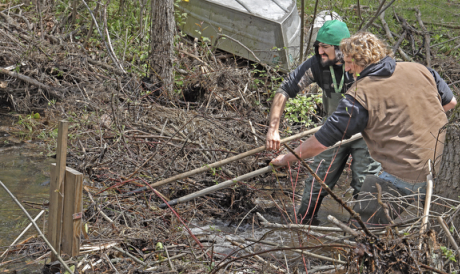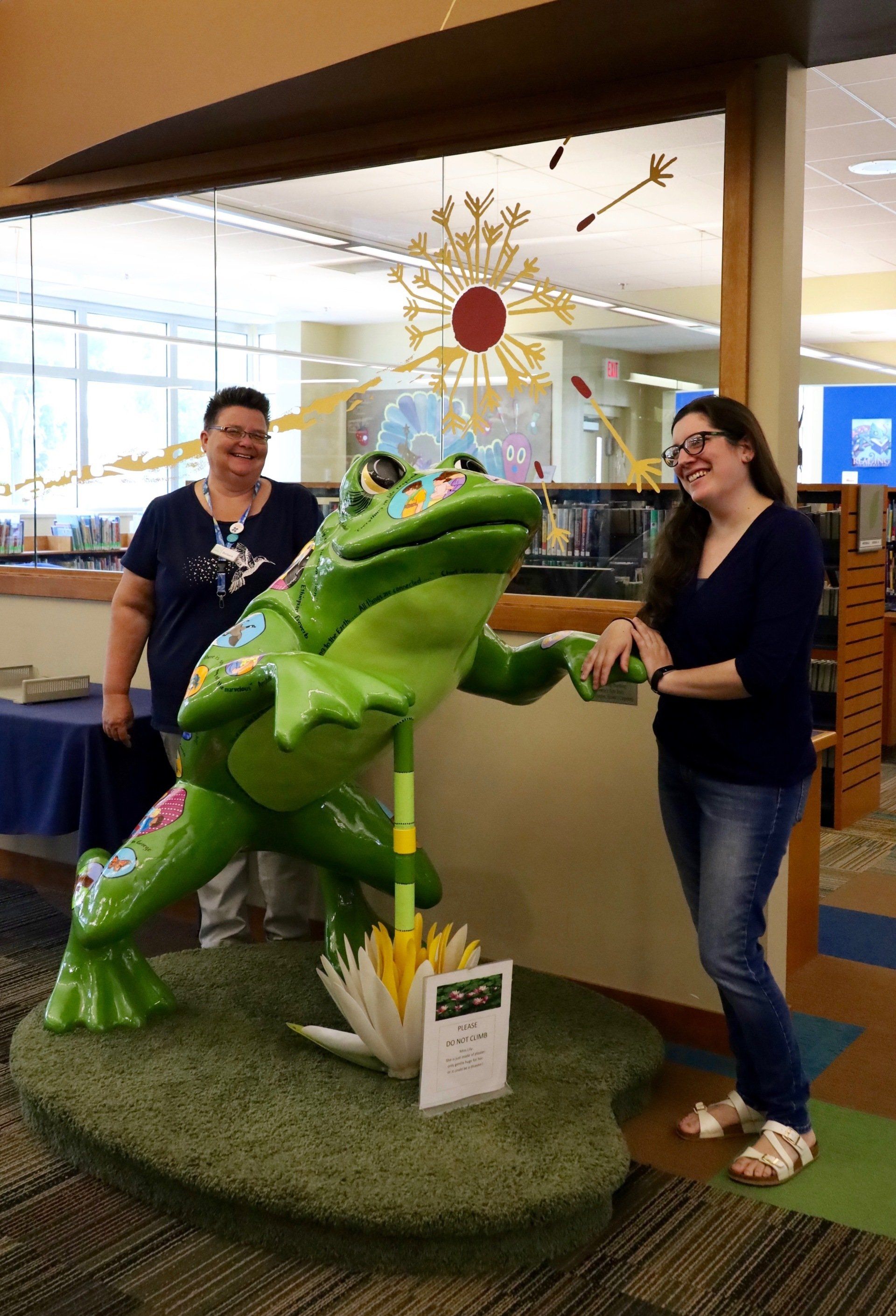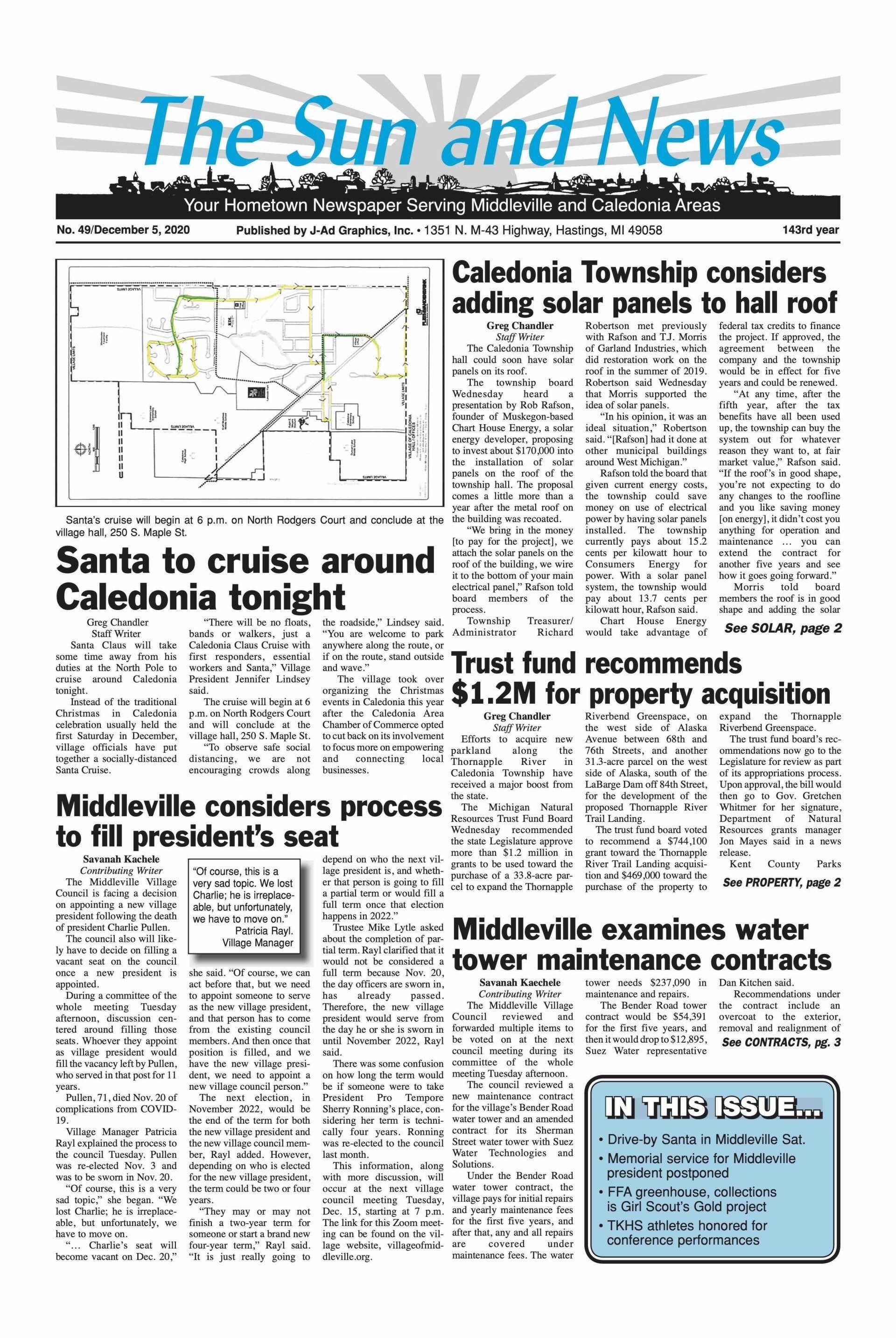Aquatic invasive species threatening Barry County lakes
Aquatic invasive species are aliens that can thrive in foreign territory.
If nothing is done to subdue these invaders, they can take over, Jason Broekstra, biologist and vice president of PLM Land and Lakes Management, said.
Invasive species choke out native plants, damage swimming locations, decrease fish population, limit species diversity, and even drive down property values, Broekstra said.
“By definition, aquatic invasive species are non-native plants or animals that negatively affect a given ecosystem,” former Prairieville Township Parks and Recreation Commission Chairman John Hoek said. “They do this, for example, by crowding native plants and animals out, reducing their food sources and destroying needed spawning areas.”
There are four predominate aquatic invasive species living in Barry County lakes: Eurasian watermilfoil, Zebra mussels, Starry stonewort and Phragmites, state Department of Natural Resources fisheries biologist Matt Diana said.
“A healthy habitat is diverse and well-suited to its specific environment,” Dr. Kenneth Kornheiser said. “Alien invasive species may get into a location and disturb the balance.”
Kornheiser, the vice president of the Kalamazoo Watershed and Four Townships Water Resource Council, said invasive species may cause a loss of natural species in a habitat.
Phragmites are a species of grass that can grow 8 or 9 feet tall, according to Sarah Nelson, executive director of the Barry County Conservation District.
They can spread along a shoreline and potentially turn the environment into a monoculture where one species dominates the rest, Kornheiser said. It can cause overgrowth on shorelines and limit fishing and impact swimming areas.
To help mitigate the spread of aquatic invasive species, Diana said DNR law requires boat plugs be removed, water drained from boats and live wells, and all vegetation be picked off trailers prior to leaving boat ramps.
“In addition, live fish should not be removed or transplanted as it is illegal because of the chance they can transport disease and invasive species,” Diana said. “Bait buckets should be dumped in the trash or on land for the same reason.”
Even with DNR law, one or more invasive species have already infiltrated several Barry County lakes. Eurasian watermilfoil and Starry stonewort are common throughout the county, including Jordan Lake in Lake Odessa.
And most area lakes do not host all four species – but Upper Crooked Lake in Delton is not like most lakes.
DNR laws and prohibitions on boat and fish movement could not stop Upper Crooked Lake from harboring all four species, Diana said.
“I was among a group of people on Crooked Lake who became concerned about the fact Crooked Lake has five invasive species – which is more than any other lake in the area,” Hoek said. “It cost [property owners] about $345,000 per seven-year assessment district period.”
Hoek and his peers broke that number down and figured out that the total cost of invasive species to property owners on Crooked Lake at that time averaged out to $48,000 per year and $9,000 per weed, per year.
“We quickly concluded that we couldn’t afford this much longer,” Hoek said. “So, we did a brief research project to collect data in the summer of 2015. We took that data to the township board and asked for a wash station on our lake.
“Research shows that wash stations are the most effective way we have right now to control invasive species.”
The movement of recreational watercraft from one body of water to another is the primary means by which aquatic invasive plants and animal are introduced into a new body of water, Hoek said.
That data led Hoek and his peers to conduct a study in 2015 before the launch was opened.
They inspected 74 watercraft entering Crooked Lake through the Prairieville Township boat launch. Over 80 percent had come from another body of water and 12 percent were judged to have not been correctly cleaned, drained, and dried.
In the summer of 2016, the boat wash on Crooked Lake was put in place with hopes of limiting the spread of invasive species in and out of the lake. It was the first boat wash in Southwest Michigan.
In summer 2017, Gull Lake joined Crooked Lake in the effort to safeguard the lake and installed a boat wash station, too.
Boat washes tend to take a few minutes. People also can wash their boats at their homes and, if the boat passes an inspection at the lake, the boat will be good to go in, Hoek said.
“At first, people were just mildly annoyed with the whole process of boat washing,” Hoek said. “But very few were vehemently against it. The level of education on boat wash stations is very low. If you ask people to define aquatic invasive species, most people couldn’t.
“But the more people being educated and having experienced the wash station, the better.”
After a year of operation, acceptance grew, Hoek said.
By the second summer, people had become much more knowledgeable about the boat wash station and more willing to have their boats cleaned before using the lake, Hoek said.
The station on Crooked Lake also includes a good-neighbor initiative to wash boats upon leaving the lake to ensure that no other lakes will contract an invasive species from Crooked Lake.
“One of the components of trying to control invasive species and their spread is to educate, educate, educate,” Hoek said. “The more they know, the better they can help us.”
In fact, one of their main goals, outside of preventing the spread of invasive species, is to educate people on the importance of the boat wash and how much impact a single contaminated boat can have, Hoek said.
“What I observed from the boats coming in through the wash station is that there were several children on the boats. And while we had literature for the adults, there was nothing for children.”
This realization drove Hoek’s desire to educate youth about aquatic invasive species and the importance of the boat wash by co-authoring a children’s book with Delton graduate Anna Bassett.
Approximately 1,000 copies were handed out at 70 locations throughout the state by the Michigan Department of Environment, Great Lakes and Energy during its “Invasive Species Awareness Week” in summer 2019, Hoek said.
Jordan Lake in Lake Odessa does not have its own boat wash station, but the lake is monitored and treated by PLM Lakes and Land Management Corp.
Broekstra and PLM western lakes manager Jaimee Desjardins went out on the lake July 17 to monitor and survey for invasive and natural species.
The most prominent invasive species on Jordan Lake is Eurasian milfoil. “Because of its invasiveness, it will out-compete other species in the area,” Broekstra said.
Biologists like Broestra and Desjardins use a sonar system to see weed buildup and species underwater, but their process of collecting aquatic invasive species and other natural species is much simpler:
Broekstra pulled out a metal rake, threw it into the water and pulled it back to the boat with a rope. When he pulled it up from the water, it was covered with a variety of native aquatic species now living in the lake.
If left unchecked, Eurasian milfoil can create “canopies” in water bodies and choke out the natural species living there. The plant also can increase the population of blue gills by making it more difficult for largemouth bass to prey upon them.
After years of treatment, Broekstra and Desjardins were unable to easily locate Eurasian milfoil during surveying, but they did address how easy that invasive species can spread.
If just one stem from the invasive species is carried from a lake that has it to another lake that doesn't, the seeds from the Eurasian milfoil plant will sink to the bottom of the lake and immediately begin to spread, Broekstra said.
If invasive species, like Eurasian milfoil, are allowed to spread, Broekstra said it can hinder native plant diversity and negatively affect lakefront property owners.
“The sooner it's addressed, the better for lake diversity,” he added.
Species like Eurasian milfoil and Starry stonewort can potentially cause an overgrowth of weeds in lakes where residents already have enough problems with overgrowth of the native species, Kornheiser said.
The spread of those two invasive species can lead to a decline in fish population, he added.
And, like many other invasive species, “if you pull or chop Eurasian milfoil, you’re just spreading it unknowingly,” Kornheiser said.
Kornheiser added that Japanese knotweed also is of great concern in Barry County. It not only causes instability in native environments, it can damage infrastructure and even grow through pavement.
If someone identifies an invasive species, the best thing to do is get expert assistance, he noted. People should not apply herbicides, pesticides, or any other poison without the proper information.
Kornheiser recommended contacting a Cooperative Invasive Species Management Area or CISMA – managed by Fallon Januska in the Barry County area. Barry, Calhoun and Kalamazoo counties are part of a statewide effort to create more effective management of – and education about – invasive plants and animals through regional community-based collaborations.
“It’s the single most useful first step,” Kornheiser said.













